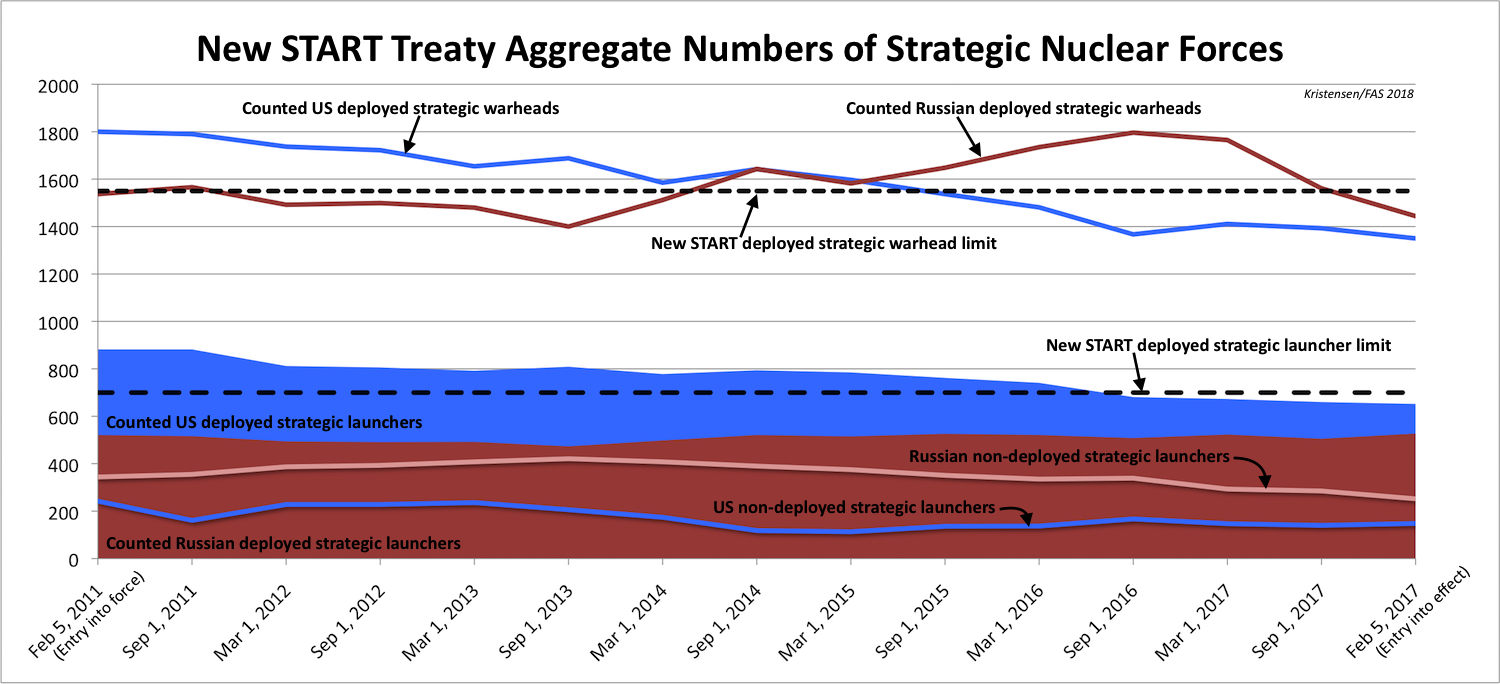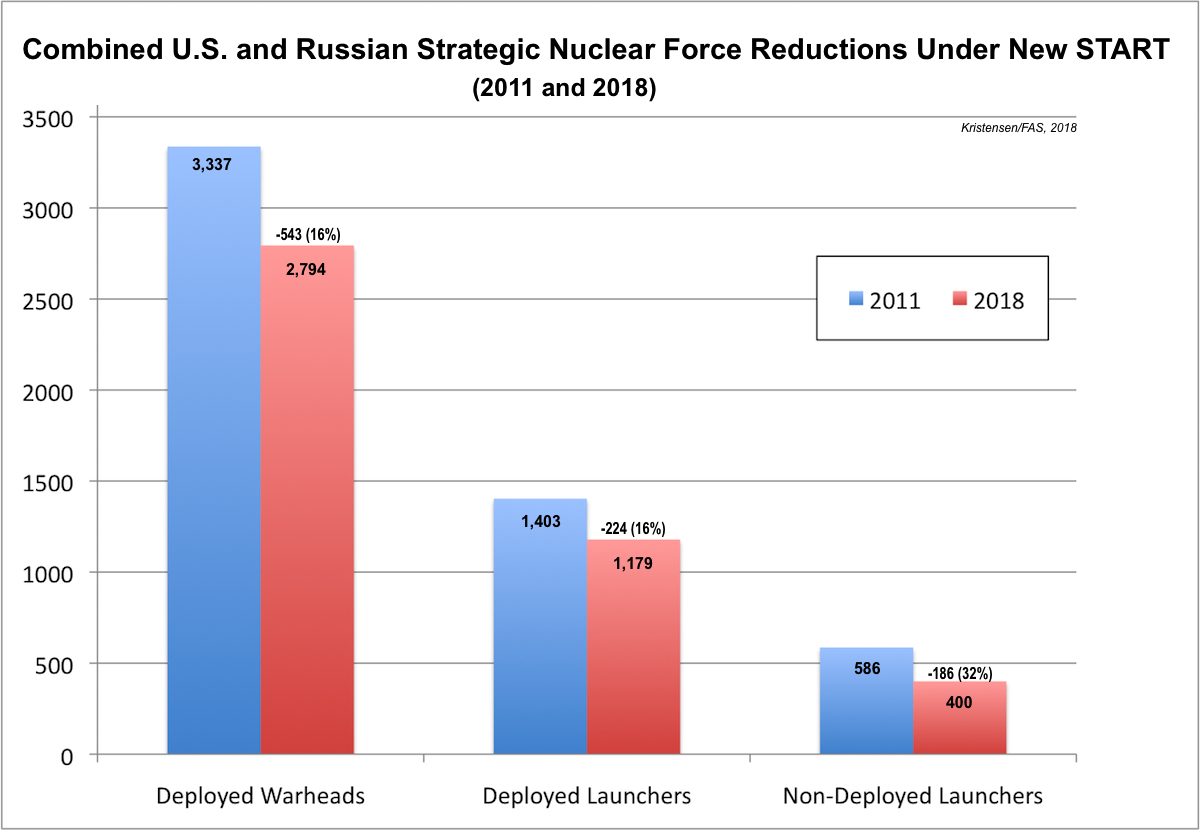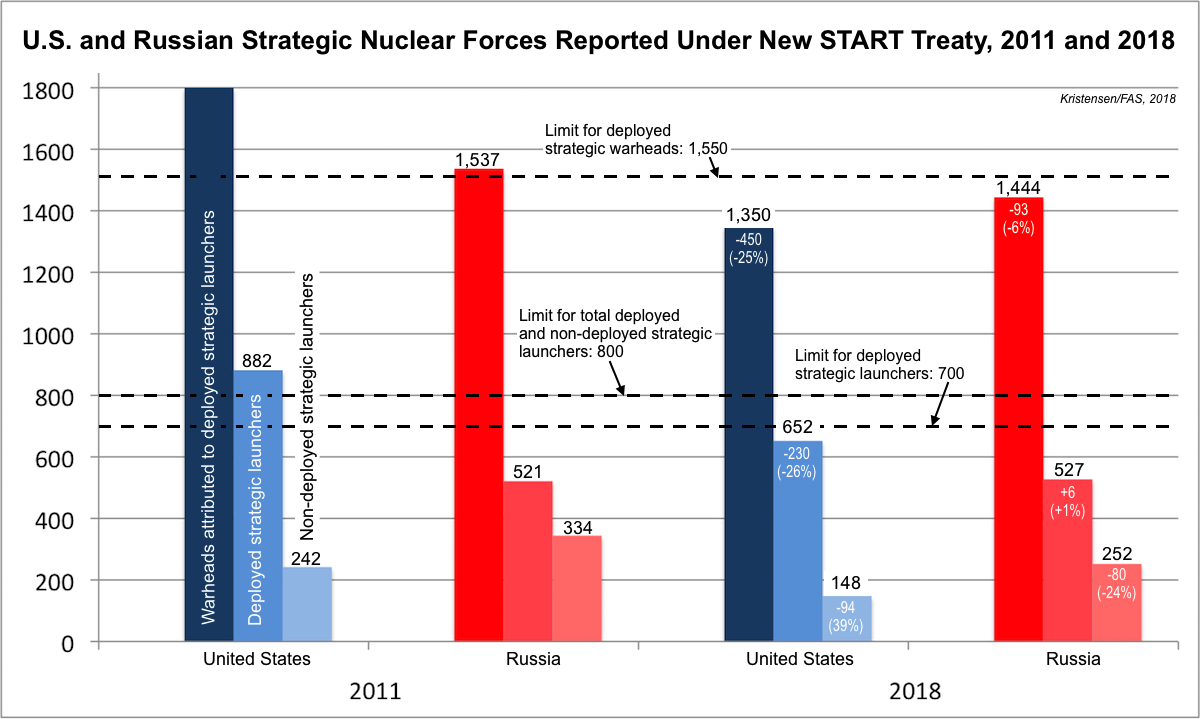After Seven Years of Implementation, New START Treaty Enters Into Effect

Russia and the United States are currently in compliance with the treaty limits of the New START treaty. This table summarizes the evolution of the three weapons categories reported between 2011 and 2018. (Click on graph to view full size.)
By Hans M. Kristensen
[Note: On February 22nd, the US State Department published updated numbers instead of relying on September 2017 numbers. This blog and tables have been updated accordingly.]
Seven years after the New START treaty between Russia and the United States entered into force in 2011, the treaty entered into effect on February 5. The two countries declared they have met the limits for strategic nuclear forces.
At a time when relations between the two countries are at a post-Cold War low and defense hawks in both countries are screaming for new nuclear weapons and declaring arms control dead, the achievement couldn’t be more timely or important.
Achievements by the Numbers
The declarations show that Russia and the United States currently deploy a combined total of 2,794 warheads on 1,179 deployed strategic launchers. An additional 400 non-deployed launchers are empty, in overhaul, or awaiting destruction.
Compare that with the same categories in 2011: 3,337 warheads on 1,403 deployed strategic launchers with an additional 586 non-deployed launchers.
In other words, since 2011, the two countries have reduced their combined strategic forces by: 543 deployed strategic warheads, 224 deployed strategic launchers, and 186 non-deployed strategic launchers. These are modest reductions of about 16 percent over seven years for deployed forces (see chart below).

The New START data shows the world’s two largest nuclear powers have reduced their deployed strategic force by about 15 percent over the past seven years. (Click on graph to view full size.)
The Russian statement reports 1,444 warheads on 527 deployed strategic launchers with another 392 non-deployed launchers.
That means Russia since 2011 has reduced its deployed strategic warheads by 93, or only 6 percent. The number of deployed launchers has increased a little, by 6, while non-deployed launchers have declined by 80, or 24 percent (see chart below).
The Russian numbers hide an important new development: In order to meet the New START treaty limit, the warhead loading on some Russian strategic missiles has been reduced. The details of the download are not apparent from the limited data published by Russia. I am currently working on developing the estimate for how the download is distributed across the Russian strategic forces. The analysis will be published in a subsequent blog, as well in our next FAS Nuclear Notebook and in the 2018 SIPRI Yearbook.
The US statement lists 1,350 warheads on 652 deployed strategic launchers, and 148 non-deployed launchers.
That means the United States since 2011 has reduced its deployed strategic warheads by 450, or 25 percent. The number of deployed launchers has been reduced by 230, or 26 percent, while the number of non-deployed launchers had declined by 94, or 39 percent (see chart below).

US and Russian strategic force structures differ significantly. As a result, the reductions under New START have affected the two countries differently. Russia has significantly fewer launchers so rely on great warhead-loading to maintain rough overall parity. (Click on chart to view full size.)
In Context
The reason for the different reductions is, of course, that the United States in 2011 had significantly more warheads and launchers deployed than Russia. During the New START negotiations, the US military insisted on a higher launcher limit than proposed by Russia. So while Russia by the latest count has 94 deployed warheads more than the United States, the United States enjoys a sizable advantage of 125 deployed strategic launchers more than Russia. Those extra launchers have a significant warhead upload capacity, a potential treaty breakout capability that Russian officials often complain about.
So despite the importance of the New START treaty and its achievements, not least its important verification regime, the declared numbers are a reminder of how far the two nuclear superpowers still have to go to reduce their unnecessarily large nuclear forces. Ironically, because the US military insisted on a higher launcher limit, Russia could – if it decided to do so, although that seems unlikely – build up its strategic launchers to reduce the US advantage, and still be in compliance with the treaty limits. The United States, in contrast, is at full capacity.
But the apparent download of warheads on Russia’s strategic missiles demonstrates an important effect of New START: It actually keeps a lid on the strategic force levels.
Still, not to forget: The deployed strategic warhead numbers counted under New START represent only a portion of the total number of warheads the two countries have in the arsenals. We estimate that the deployed strategic warheads declared by the two countries represent on about one-third of the total number of warheads in their nuclear stockpiles (see here for details).
This all points to the importance of the two countries agreeing to extend the New START treaty for an additional five years before it expires in 2021. Neither can afford to abandon the only strategic limitations treaty and its verification regime. Failing this most basic responsibility would, especially in the current political climate, remove any caps on strategic nuclear forces and potentially open the door to a new nuclear arms race. The warning signs are all there: East and West are in an official adversarial relationship, increasing military posturing, modernizing and adding nuclear weapons to their arsenals, and adjusting their nuclear policies for a return to Great Power competition.
The symbolic importance of New START could not be greater!
This publication was made possible by a grant from the Carnegie Corporation of New York, the John D. and Catherine T. MacArthur Foundation, the New Land Foundation, and the Ploughshares Fund. The statements made and views expressed are solely the responsibility of the author.
The FY2026 National Defense Authorization Act (NDAA) paints a picture of a Congress that is working to both protect and accelerate nuclear modernization programs while simultaneously lacking trust in the Pentagon and the Department of Energy to execute them.
While advanced Chinese language proficiency and cultural familiarity remain irreplaceable skills, they are neither necessary nor sufficient for successful open-source analysis on China’s nuclear forces.
Satellite imagery has long served as a tool for observing on-the-ground activity worldwide, and offers especially valuable insights into the operation, development, and physical features related to nuclear technology.
This report outlines a framework relying on “Cooperative Technical Means” for effective arms control verification based on remote sensing, avoiding on-site inspections but maintaining a level of transparency that allows for immediate detection of changes in nuclear posture or a significant build-up above agreed limits.